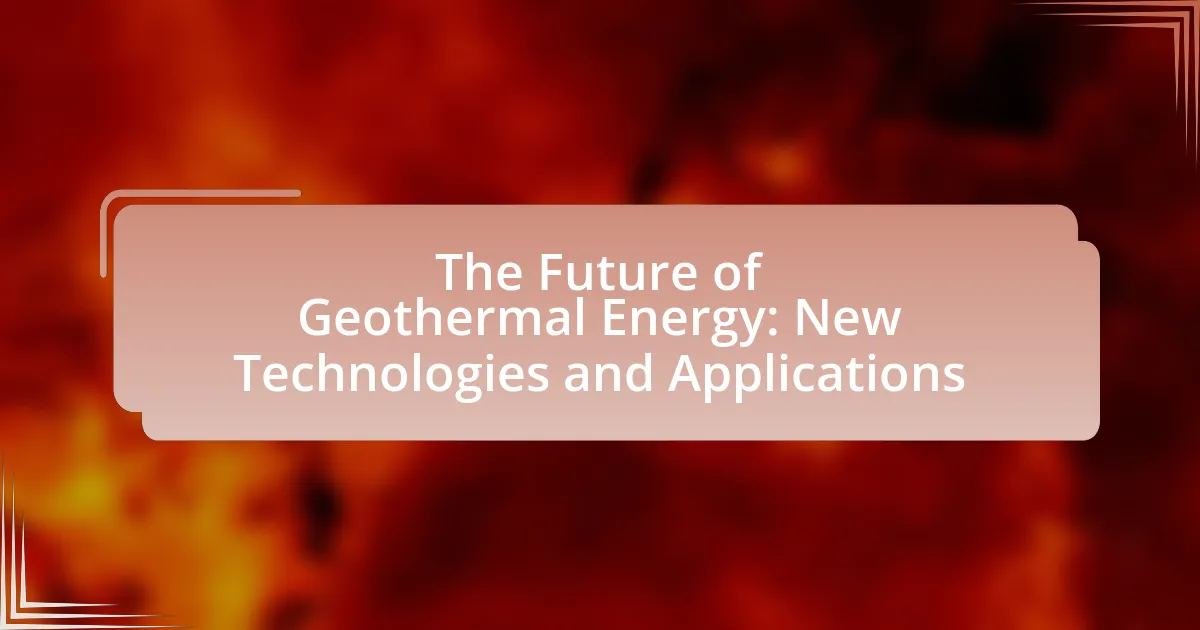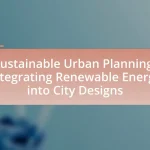Geothermal energy, derived from the Earth’s internal heat, is a renewable and sustainable energy source with significant potential for future applications. This article explores the mechanisms of geothermal energy generation, including various systems such as ground-source heat pumps and geothermal power plants, and highlights its current applications in electricity generation and direct heating. It also discusses the environmental benefits of geothermal energy, advancements in technology like enhanced geothermal systems, and the challenges faced by the sector, including economic and regulatory barriers. Furthermore, the article examines future trends, the integration of geothermal energy with other renewable sources, and practical steps for promoting its adoption.

What is Geothermal Energy and Why is it Important for the Future?
Geothermal energy is the heat that comes from the Earth’s interior, which can be harnessed for electricity generation and direct heating applications. This energy source is important for the future because it is renewable, sustainable, and has a low environmental impact compared to fossil fuels. According to the U.S. Department of Energy, geothermal energy can provide a continuous and reliable power supply, contributing to energy security and reducing greenhouse gas emissions. Additionally, advancements in technology, such as enhanced geothermal systems, are expanding the potential for geothermal energy utilization, making it a key player in the transition to a cleaner energy future.
How does geothermal energy work?
Geothermal energy works by harnessing heat from the Earth’s interior to generate electricity or provide direct heating. This process involves drilling wells into geothermal reservoirs, where hot water or steam is extracted. The extracted steam drives turbines connected to generators, producing electricity. According to the U.S. Department of Energy, geothermal power plants can achieve an efficiency of up to 20% in converting geothermal heat into electricity, making it a reliable and sustainable energy source.
What are the different types of geothermal energy systems?
The different types of geothermal energy systems include ground-source heat pumps, direct-use systems, and geothermal power plants. Ground-source heat pumps utilize the stable temperatures of the earth to heat and cool buildings, making them efficient for residential and commercial applications. Direct-use systems harness hot water from geothermal reservoirs for heating purposes, such as in district heating or agricultural processes. Geothermal power plants convert geothermal energy into electricity, with types including dry steam, flash steam, and binary cycle plants, each utilizing different methods to extract and convert heat from the earth. These systems collectively contribute to the sustainable use of geothermal resources, which are abundant and renewable.
What are the key processes involved in harnessing geothermal energy?
The key processes involved in harnessing geothermal energy include resource identification, drilling, extraction, and energy conversion. Resource identification involves geological surveys and assessments to locate geothermal reservoirs, which are typically found in volcanic or tectonically active regions. Drilling is the process of creating wells to access hot water or steam from these reservoirs, often requiring advanced technology to reach depths of several kilometers.
Extraction involves bringing the geothermal fluid to the surface, where it can be used directly for heating or converted into electricity. The energy conversion process typically employs geothermal power plants, which utilize steam turbines or binary cycle systems to generate electricity from the extracted heat. According to the U.S. Department of Energy, geothermal energy can provide a reliable and sustainable energy source, with the potential to supply up to 10% of the nation’s electricity needs by 2050.
What are the current applications of geothermal energy?
Current applications of geothermal energy include electricity generation, direct heating, and geothermal heat pumps. Electricity generation utilizes geothermal power plants, which convert steam or hot water from the Earth’s interior into electricity; in 2021, geothermal energy contributed approximately 0.4% of the total electricity generation in the United States. Direct heating applications involve using geothermal resources for district heating systems, greenhouse heating, and aquaculture, providing efficient heating solutions for residential and commercial buildings. Geothermal heat pumps leverage the stable temperatures below the Earth’s surface for heating and cooling, achieving energy efficiency ratings that can be three to four times higher than conventional systems. These applications demonstrate the versatility and sustainability of geothermal energy in meeting energy needs.
How is geothermal energy used in electricity generation?
Geothermal energy is used in electricity generation by harnessing heat from the Earth’s interior to produce steam that drives turbines. This process typically involves drilling wells into geothermal reservoirs to access hot water or steam, which is then brought to the surface. The steam is directed to turbines, converting thermal energy into mechanical energy, which is subsequently transformed into electrical energy through generators. According to the U.S. Department of Energy, geothermal power plants can achieve efficiencies of up to 20% to 25%, making them a viable renewable energy source.
What role does geothermal energy play in direct heating applications?
Geothermal energy serves a crucial role in direct heating applications by providing a sustainable and efficient source of thermal energy for residential, commercial, and industrial uses. This energy is harnessed from the Earth’s internal heat, which can be utilized for space heating, water heating, and even agricultural processes. For instance, according to the U.S. Department of Energy, geothermal heat pumps can reduce energy costs by 30-60% compared to conventional heating systems, demonstrating their effectiveness and economic viability. Additionally, direct use applications of geothermal energy have been implemented in over 70 countries, showcasing its global relevance and potential for widespread adoption in future energy systems.
What are the environmental benefits of geothermal energy?
Geothermal energy offers significant environmental benefits, primarily through its low greenhouse gas emissions. Unlike fossil fuels, geothermal power plants emit approximately 90% less carbon dioxide, contributing to a reduction in climate change impacts. Additionally, geothermal energy utilizes the Earth’s natural heat, which is a renewable resource, thus minimizing reliance on finite resources and reducing habitat destruction associated with fossil fuel extraction. Furthermore, geothermal systems have a small land footprint compared to other renewable energy sources, preserving more natural habitats. Studies indicate that the life cycle emissions of geothermal energy are among the lowest of all energy sources, reinforcing its role as a sustainable energy solution.
How does geothermal energy compare to fossil fuels in terms of emissions?
Geothermal energy produces significantly lower emissions compared to fossil fuels. While fossil fuel combustion releases large amounts of carbon dioxide and other greenhouse gases, geothermal energy systems emit only a fraction of these pollutants, primarily due to their reliance on the Earth’s natural heat rather than combustion processes. For instance, geothermal power plants emit about 10% of the carbon dioxide per unit of electricity generated compared to natural gas plants, and nearly 0% compared to coal plants. This stark difference highlights geothermal energy’s potential as a cleaner alternative in the transition to sustainable energy sources.
What impact does geothermal energy have on land use and biodiversity?
Geothermal energy impacts land use and biodiversity primarily by altering land cover and potentially affecting local ecosystems. The development of geothermal power plants often requires significant land for infrastructure, which can lead to habitat fragmentation and displacement of species. For instance, a study by the U.S. Department of Energy indicates that geothermal plants can occupy 1 to 8 acres per megawatt, depending on the technology used, which can disrupt local flora and fauna. Additionally, the extraction of geothermal resources can lead to changes in groundwater levels and temperatures, further influencing biodiversity in surrounding areas.
What new technologies are emerging in geothermal energy?
Emerging technologies in geothermal energy include enhanced geothermal systems (EGS), which utilize hydraulic fracturing to access geothermal resources in areas with insufficient natural permeability. EGS can significantly expand the geographical range of geothermal energy production, allowing for energy extraction in regions previously deemed unsuitable. Additionally, advancements in binary cycle power plants enable the use of lower temperature geothermal resources, increasing efficiency and broadening the potential for geothermal energy utilization. According to the U.S. Department of Energy, these technologies can potentially unlock an estimated 100 gigawatts of geothermal energy capacity in the United States alone by 2050.
How are enhanced geothermal systems (EGS) changing the landscape of geothermal energy?
Enhanced geothermal systems (EGS) are significantly transforming the geothermal energy landscape by enabling the extraction of heat from previously inaccessible geothermal resources. EGS technology involves creating artificial reservoirs in hot, dry rock formations by injecting water to enhance permeability, which allows for efficient heat extraction. This innovation expands the potential for geothermal energy production beyond traditional hydrothermal resources, increasing the number of viable sites for geothermal power plants. According to the U.S. Department of Energy, EGS could provide up to 100 gigawatts of additional geothermal capacity in the United States alone, demonstrating its potential to substantially contribute to renewable energy goals and reduce reliance on fossil fuels.
What advancements in drilling technology are being developed for geothermal applications?
Advancements in drilling technology for geothermal applications include the development of enhanced geothermal systems (EGS), which utilize advanced drilling techniques to access deeper geothermal resources. These techniques involve the use of high-temperature resistant materials and innovative drilling methods such as rotary drilling and laser-assisted drilling, which improve efficiency and reduce costs. For instance, the use of polycrystalline diamond compact (PDC) bits allows for faster penetration rates and better performance in high-temperature environments. Additionally, technologies like directional drilling enable more precise targeting of geothermal reservoirs, maximizing energy extraction. These advancements are supported by research from institutions such as the U.S. Department of Energy, which highlights the potential for increased geothermal energy production through improved drilling technologies.
What challenges does the geothermal energy sector face?
The geothermal energy sector faces several significant challenges, including high initial capital costs, resource location limitations, and regulatory hurdles. High initial capital costs can deter investment, as developing geothermal plants requires substantial upfront expenditure for exploration and drilling, often exceeding $5 million per well. Resource location limitations arise because geothermal resources are geographically specific, often found in tectonically active regions, which restricts accessibility and development opportunities. Regulatory hurdles include complex permitting processes and varying policies across regions, which can delay project timelines and increase costs. These challenges collectively hinder the growth and expansion of geothermal energy as a viable renewable energy source.
What are the economic barriers to geothermal energy development?
The economic barriers to geothermal energy development include high initial capital costs, limited access to financing, and market competition from other energy sources. High initial capital costs are often associated with exploration, drilling, and infrastructure development, which can exceed millions of dollars before any energy is produced. Limited access to financing arises because investors may perceive geothermal projects as risky due to uncertainties in resource availability and long payback periods. Additionally, market competition from cheaper fossil fuels and renewable sources, such as solar and wind, can hinder the economic viability of geothermal projects, as these alternatives may offer lower upfront costs and quicker returns on investment.
How do regulatory and permitting issues affect geothermal projects?
Regulatory and permitting issues significantly impact geothermal projects by influencing the timeline, cost, and feasibility of development. These issues often involve complex legal frameworks that require compliance with environmental regulations, land use policies, and resource management laws. For instance, obtaining permits can take several years, delaying project initiation and increasing costs due to prolonged planning and legal consultations. Additionally, stringent regulations may limit the areas available for geothermal exploration and development, thereby restricting potential project sites. According to the Geothermal Energy Association, regulatory hurdles are among the top challenges faced by developers, affecting investment decisions and overall project viability.
How can geothermal energy be integrated with other renewable sources?
Geothermal energy can be integrated with other renewable sources through hybrid systems that combine geothermal with solar, wind, or biomass energy. These hybrid systems enhance overall energy efficiency and reliability by utilizing geothermal energy for base-load power generation while supplementing it with variable renewable sources like solar and wind during peak demand periods. For instance, a study by the National Renewable Energy Laboratory found that integrating geothermal with solar photovoltaic systems can optimize energy output and reduce reliance on fossil fuels, demonstrating a practical application of this integration.
What are the benefits of hybrid systems combining geothermal with solar or wind energy?
Hybrid systems combining geothermal with solar or wind energy enhance energy reliability and efficiency. These systems leverage the continuous energy production of geothermal sources alongside the intermittent nature of solar and wind, ensuring a more stable energy supply. For instance, geothermal energy can provide a consistent base load, while solar and wind can contribute during peak demand periods, thus optimizing resource utilization. Additionally, integrating these renewable sources can reduce greenhouse gas emissions significantly, as studies indicate that hybrid systems can lower carbon footprints by up to 50% compared to conventional fossil fuel systems. This synergy not only maximizes energy output but also minimizes reliance on fossil fuels, promoting a sustainable energy future.
How can geothermal energy contribute to energy storage solutions?
Geothermal energy can contribute to energy storage solutions by utilizing underground thermal reservoirs to store excess energy in the form of heat. This stored thermal energy can be released during periods of high demand, effectively balancing supply and demand in the energy grid. For instance, systems like geothermal heat pumps can store heat in the ground during warmer months and retrieve it during colder months, providing a reliable energy source. Additionally, research indicates that geothermal energy can be integrated with other renewable sources, enhancing overall energy storage capabilities and grid stability.
What are the future trends in geothermal energy applications?
Future trends in geothermal energy applications include enhanced geothermal systems (EGS), which allow for energy extraction in areas with limited natural geothermal resources, and the integration of geothermal energy with district heating systems to improve efficiency. EGS technology is advancing rapidly, with projects like the 2020 demonstration in the United States showing the potential to significantly expand geothermal energy access. Additionally, the use of geothermal energy for direct heating applications, such as in agriculture and aquaculture, is expected to grow, driven by the need for sustainable practices. The global geothermal market is projected to reach $60 billion by 2025, indicating a strong trend towards increased investment and development in this sector.
How is geothermal energy expected to evolve in urban settings?
Geothermal energy is expected to evolve in urban settings through the integration of advanced technologies such as enhanced geothermal systems (EGS) and ground-source heat pumps. These innovations will enable cities to harness geothermal resources more efficiently, reducing reliance on fossil fuels and lowering greenhouse gas emissions. For instance, the International Renewable Energy Agency (IRENA) reports that urban areas can utilize shallow geothermal resources for heating and cooling, which can significantly decrease energy costs and improve energy security. As urban populations grow, the demand for sustainable energy solutions will drive the adoption of geothermal systems, making them a key component of smart city infrastructure.
What potential does geothermal energy have in developing countries?
Geothermal energy has significant potential in developing countries as a sustainable and reliable energy source. This potential is highlighted by the fact that many developing nations possess untapped geothermal resources, which can provide a stable energy supply, reduce reliance on fossil fuels, and promote energy independence. For instance, countries like Kenya and the Philippines have successfully harnessed geothermal energy, contributing to over 50% of their electricity generation. Additionally, the International Renewable Energy Agency (IRENA) reports that geothermal energy can create jobs and stimulate local economies, further enhancing its value in these regions.
What practical steps can be taken to promote geothermal energy adoption?
To promote geothermal energy adoption, governments and organizations should implement supportive policies, provide financial incentives, and invest in research and development. Supportive policies, such as streamlined permitting processes and renewable energy mandates, can facilitate project development. Financial incentives, including tax credits and grants, can lower the initial investment barrier for geothermal projects. Additionally, investing in research and development can lead to technological advancements that improve efficiency and reduce costs. For instance, the U.S. Department of Energy’s Geothermal Technologies Office has funded projects that enhance geothermal resource exploration and utilization, demonstrating the effectiveness of targeted investment in this sector.
What policies can governments implement to support geothermal energy projects?
Governments can implement several policies to support geothermal energy projects, including financial incentives, regulatory frameworks, and research funding. Financial incentives such as tax credits, grants, and low-interest loans can reduce the initial investment burden for geothermal developers. Regulatory frameworks that streamline permitting processes and provide clear guidelines can facilitate project development. Additionally, funding for research and development can drive innovation in geothermal technologies, enhancing efficiency and reducing costs. For instance, the U.S. Department of Energy has allocated millions in funding for geothermal research, demonstrating the effectiveness of government support in advancing this energy sector.
How can individuals and businesses invest in geothermal energy solutions?
Individuals and businesses can invest in geothermal energy solutions by purchasing shares in geothermal energy companies, funding geothermal projects through crowdfunding platforms, or installing geothermal heating and cooling systems in their properties. Investing in publicly traded companies involved in geothermal energy, such as Ormat Technologies, allows individuals to gain exposure to the sector. Additionally, businesses can participate in joint ventures or partnerships with geothermal developers to support new projects. The global geothermal energy market is projected to grow significantly, with a compound annual growth rate of 5.6% from 2021 to 2028, indicating a strong potential for returns on investment in this renewable energy sector.


